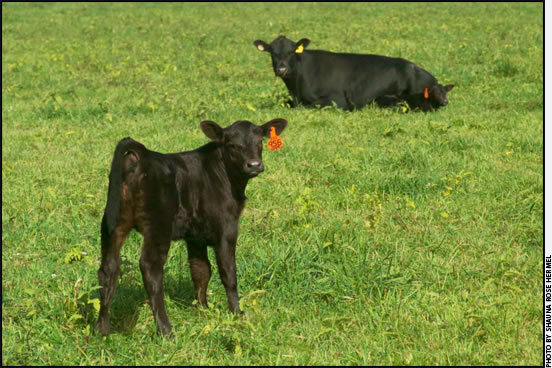
Calving Season Considerations
Experts share tips for re-evaluating calving date.
After a long, snowy and cold winter, calving in June — rather than the traditional January through March calving season — may have some appeal for northern ranchers. Extension specialists say not only is the weather more favorable in June, but the forages are better matched to that calving time as well.
"Increasingly, ranchers are recognizing that matching the physiology of the cow with the physiology of the plant is an important key to reducing costs," says Jack Whittier, Extension beef specialist at Colorado State University (CSU). "When calving season more closely matches forage growth, the cow is better able to meet her increased nutrient demand for milk production from grazing rather than from more expensive harvested feeds and supplementation."
Aaron Stalker, assistant professor of ruminant nutrition at the University of Nebraska's West Central Research and Extension Center in North Platte, agrees.
"One of the most common mistakes is that people try to change the forage nutrient supply to meet the cow's needs. I suggest doing it the other way around. Matching the cow's needs to available forage nutrients is more profitable," Stalker says.
Stalker says a change in calving date to better match forage resources can be a cost-effective option. He reports that research at the Gudmundson Sandhills Laboratory, which is operated as a working Nebraska ranch, has gathered data comparing June- and March-calving herds for several years, and the June herd is more profitable than the March herd.
"The reason is because the June-calving herd has lower costs (primarily because of the need for less hay to be fed), not necessarily higher revenue," Stalker explains. He says this is a prime example of how matching forage resources to the cow's nutrient needs can help reduce feed costs.
Stalker adds that more producers seem to recognize this and, at least in Nebraska, they are starting to see a shift toward more summer and fall calving. He cites a survey conducted in 1992 of producers in Western and Central Nebraska to monitor in what season ranch operations calve. When a follow-up survey was conducted in 2002, an increasing number of summer and fall calving dates were revealed.
Stalker recognizes that for some operations a change to summer calving may not be an option if they have farm ground and field work that take the bulk of their labor supply during the summer. But for those ranchers who calve in the spring simply because of tradition, he suggests it might be worth giving a second thought.
Points to ponder
If you are considering a shift in your calving season date, CSU Extension range specialist Roy Roath emphasizes it's not just about changing the time when cows are bred. "Changing the calving season makes a profound difference on forage management. Producers need to look at the types of forage they have available, the grazing pressure on them during different seasons, and determine carrying capacity," he says.
As an example, Roath points out that with summer calving, young calves are often carried over to the following spring. This can pose some new management concerns. For instance, Roath says the increased number of management groups needs to be addressed. And, if you plan to keep calves over the winter, determine how you'll manage and market them. "It's important to look at flexibility," Roath says.
He suggests answering the following questions:
• Are you prepared to handle young calves during winter storms?
• Will you be able to handle multiple herds such as cow-calf, bulls, yearling steers and heifers, and 2-year-old cows during that timeframe?
• Do you have enough forage?
• What will your marketing plan be to fit this new system?
Additionally, CSU's Whittier adds, "The benefits of price cycles by marketing calves during times when supplies are traditionally lower and prices are higher is a consideration. But the impact on cash flow must also play into the planning for such changes."
Overall, Roath says, "Producers need to think through their contingency plan. When a new system is properly thought through, it can be a benefit to the operation. Without planning it can become a disaster."
His advice to ranchers evaluating a change in calving season is to pay particular attention to available forage and carrying capacity. He suggests that leasing pasture or crop residue may be necessary.
Whittier and Roath say the bottom line is that there are several interacting factors that a rancher must consider before moving away from the traditional calving date.
And, to those operations that plan to continue with a spring-calving herd, UNL's Stalker suggests looking for ways to extend grazing options as much as possible through stockpiled forages or crop residues.
He tells that the Gudmundson Lab has conducted research looking at the amount of hay fed and has found that extending winter grazing of a March-calving herd can help reduce the amount of hay fed compared to traditional feeding.
"Whenever a producer can extend grazing of winter range, feed costs can be decreased," Stalker says.
Comment on this article.
[Click here to go to the top of the page.]







